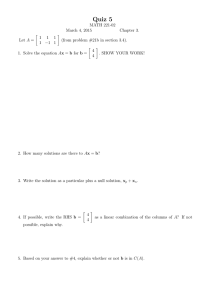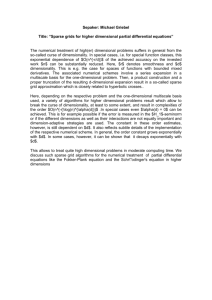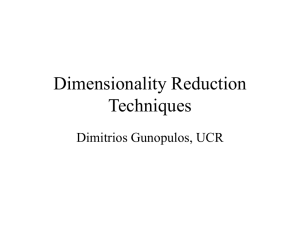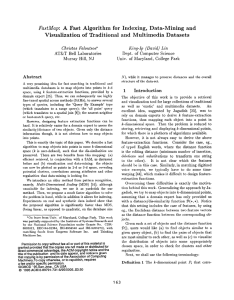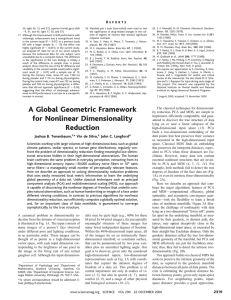Dimensionality reduction
advertisement
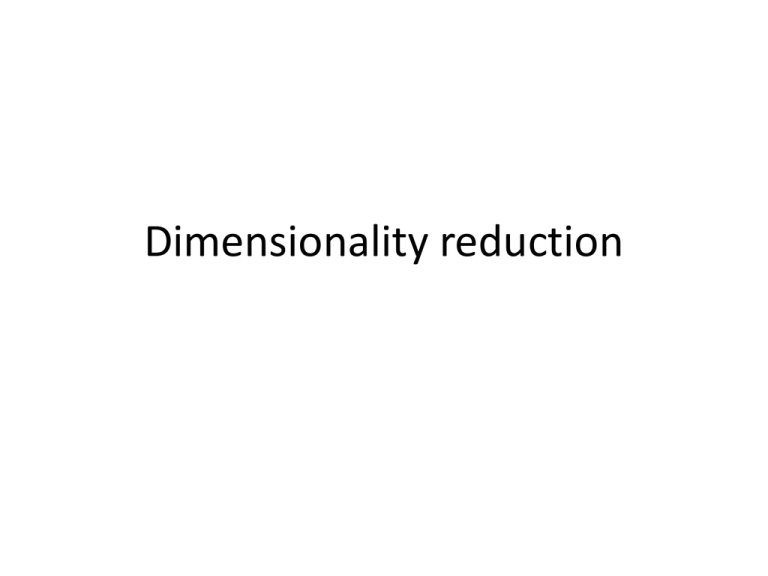
Dimensionality reduction Outline • From distances to points : – MultiDimensional Scaling (MDS) – FastMap • Dimensionality Reductions or data projections • Random projections • Principal Component Analysis (PCA) Multi-Dimensional Scaling (MDS) • So far we assumed that we know both data points X and distance matrix D between these points • What if the original points X are not known but only distance matrix D is known? • Can we reconstruct X or some approximation of X? Problem • Given distance matrix D between n points • Find a k-dimensional representation of every xi point i • So that d(xi,xj) is as close as possible to D(i,j) Why do we want to do that? How can we do that? (Algorithm) High-level view of the MDS algorithm • Randomly initialize the positions of n points in a k-dimensional space • Compute pairwise distances D’ for this placement • Compare D’ to D • Move points to better adjust their pairwise distances (make D’ closer to D) • Repeat until D’ is close to D The MDS algorithm • • • • Input: nxn distance matrix D Random n points in the k-dimensional space (x1,…,xn) stop = false while not stop – totalerror = 0.0 – For every i,j compute • D’(i,j)=d(xi,xj) • error = (D(i,j)-D’(i,j))/D(i,j) • totalerror +=error • For every dimension m: xim = (xim-xjm)/D’(i,j)*error – If totalerror small enough, stop = true Questions about MDS • Running time of the MDS algorithm – O(n2I), where I is the number of iterations of the algorithm • MDS does not guarantee that metric property is maintained in d’ • Faster? Guarantee of metric property? Problem (revisited) • Given distance matrix D between n points • Find a k-dimensional representation of every xi point i • So that: – d(xi,xj) is as close as possible to D(i,j) – d(xi,xj) is a metric – Algorithm works in time linear in n FastMap • Select two pivot points xa and xb that are far apart. • Compute a pseudo-projection of the remaining points along the “line” xaxb • “Project” the points to a subspace orthogonal to “line” xaxb and recurse. Selecting the Pivot Points The pivot points should lie along the principal axes, and hence should be far apart. – Select any point x0 – Let x1 be the furthest from x0 – Let x2 be the furthest from x1 – Return (x1, x2) x2 x0 x1 Pseudo-Projections xb Given pivots (xa , xb ), for any third point y, we use the law of cosines to determine the relation of y along xaxb d by2 d ay2 d ab2 2c y d ab The pseudo-projection for y is d ay2 d ab2 d by2 cy 2d ab This is first coordinate. db,y da,b y cy da,y xa “Project to orthogonal plane” cz-cy xb Given distances along xaxb d compute distances within the “orthogonal hyperplane” y z y,z d '(y ', z ') d 2 (y , z ) (c z c y )2 Recurse using d ’(.,.), until k features chosen. xa y’ d’y’,z’ z’ The FastMap algorithm • D: distance function, Y: nxk data points • f=0 //global variable • FastMap(k,D) – – – – – – – If k<=0 return (xa,xb) chooseDistantObjects(D) If(D(xa,xb)==0), set Y[i,f]=0 for every i and return Y[i,f] = [D(a,i)2+D(a,b)2-D(b,i)2]/(2D(a,b)) D’(i,j) // new distance function on the projection f++ FastMap(k-1,D’) FastMap algorithm • Running time – Linear number of distance computations The Curse of Dimensionality • Data in only one dimension is relatively packed • Adding a dimension “stretches” the points across that dimension, making them further apart • Adding more dimensions will make the points further apart—high dimensional data is extremely sparse • Distance measure becomes meaningless (graphs from Parsons et al. KDD Explorations 2004) The curse of dimensionality • The efficiency of many algorithms depends on the number of dimensions d – Distance/similarity computations are at least linear to the number of dimensions – Index structures fail as the dimensionality of the data increases Goals • Reduce dimensionality of the data • Maintain the meaningfulness of the data Dimensionality reduction • Dataset X consisting of n points in a ddimensional space • Data point xiєRd (d-dimensional real vector): xi = [xi1, xi2,…, xid] • Dimensionality reduction methods: – Feature selection: choose a subset of the features – Feature extraction: create new features by combining new ones Dimensionality reduction • Dimensionality reduction methods: – Feature selection: choose a subset of the features – Feature extraction: create new features by combining new ones • Both methods map vector xiєRd, to vector yi є Rk, (k<<d) • F : RdRk Linear dimensionality reduction • Function F is a linear projection • yi = A xi • Y=AX • Goal: Y is as close to X as possible Closeness: Pairwise distances • Johnson-Lindenstrauss lemma: Given ε>0, and an integer n, let k be a positive integer such that k≥k0=O(ε-2 logn). For every set X of n points in Rd there exists F: RdRk such that for all xi, xj єX (1-ε)||xi - xj||2≤ ||F(xi )- F(xj)||2≤ (1+ε)||xi - xj||2 What is the intuitive interpretation of this statement? JL Lemma: Intuition • Vectors xiєRd, are projected onto a kdimensional space (k<<d): yi = R xi • If ||xi||=1 for all i, then, ||xi-xj||2 is approximated by (d/k)||xi-xj||2 • Intuition: – The expected squared norm of a projection of a unit vector onto a random subspace through the origin is k/d – The probability that it deviates from expectation is very small JL Lemma: More intuition • x=(x1,…,xd), d independent Gaussian N(0,1) random variables; y = 1/|x|(x1,…,xd) • z : projection of y into first k coordinates – L = |z|2, μ = E[L] = k/d • Pr(L ≥ (1+ε)μ)≤1/n2 and Pr(L ≤ (1-ε)μ)≤1/n2 • f(y) = sqrt(d/k)z • What is the probability that for pair (y,y’): |f(y)f(y’)|2/(|y-y’|) does not lie in range [(1-ε),(1+ ε)]? • What is the probability that some pair suffers? Finding random projections • Vectors xiєRd, are projected onto a kdimensional space (k<<d) • Random projections can be represented by linear transformation matrix R • yi = R xi • What is the matrix R? Finding random projections • Vectors xiєRd, are projected onto a kdimensional space (k<<d) • Random projections can be represented by linear transformation matrix R • yi = R xi • What is the matrix R? Finding matrix R • Elements R(i,j) can be Gaussian distributed • Achlioptas* has shown that the Gaussian distribution can be replaced by 1 1 with prob 6 2 R (i , j ) 0 with prob 3 1 with prob 1 6 • All zero mean, unit variance distributions for R(i,j) would give a mapping that satisfies the JL lemma • Why is Achlioptas result useful?
